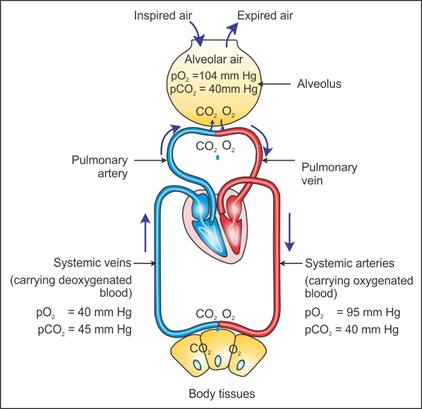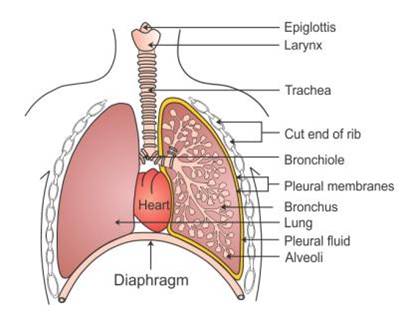Q1. Name the muscles which increase the volume of the thoracic chamber.
Solution
External intercostal muscles
Q2. Represent diagrammatically the exchange of gases at the alveolar level and the tissue level.
Solution

Q3. Describe the process of expiration.
Solution
When the diaphragm and intercostal muscles are relaxed, the thoracic
chamber comes to its normal volume.
This reduces the pulmonary volume. This results in an increase in the intra-pulmonary
pressure in the lungs than the atmospheric pressure causing the expulsion of
air from the lungs.
Q4. Name the following:
Volume
of air which remains in the lungs after normal expiration
Total
volume of air a person can inspire after normal expiration
Solution
Q5. What does RV stand for? What is the average RV for a healthy person?
Solution
Residual volume. The average RV for a healthy person is 1100 to 1200
ml.
Q6. With respect to the partial pressures of oxygen and carbon dioxide,
when are more molecules of carbaminohaemoglobin formed?
Solution
When the partial pressure CO2 (pCO2) is high and
the partial pressure of O2 (pO2) is low, more
carbaminohaemoglobin molecules are formed.
Q7. Name the structure which divides into the right and left bronchiole.
Solution
Trachea
Q8. Mention the two factors which can affect the rate of diffusion of oxygen and carbon dioxide during respiration.
Solution
The two factors which can affect the rate of diffusion of oxygen and carbon dioxide during respiration are as follows:
Solubility of gases
Thickness of the membranes involved in diffusion
Q9. Where is the pneumotaxic region located in the brain?
Solution
Pons
Q10. Name the substance formed after the combination of oxygen and
haemoglobin.
Solution
Oxyhaemoglobin
Q11. What is the average breathing rate in a healthy human?
Solution
The average breathing rate in a healthy human is 12-16 times per
minute.
Q12. Where is carbonic anhydrase found? Write the reaction it catalyses.
Solution
Carbonic anhydrase is found in RBCs. It catalyses the following reaction:


Q13. Define rhythmicity centres.
Solution
Basic rhythm of respiration is regulated by three respiratory centres located in the floor of medulla oblongata and pons Varolli. These centres are together called rhythmicity centres.
Q14. Name the region present in the central nervous system which regulates
respiration.
Solution
Respiratory rhythm centre
Q15. Name the two blood vessels which recognise the changes in H+
ions and CO2.
Solution
Aortic arch and carotid artery
Q16. State the significance of the larynx.
Solution
The larynx is responsible for sound production.
Q17. What is fibrosis and how is it caused?
Solution
Fibrosis is the uncontrolled proliferation of fibrous tissue which causes serious lung damage. Long exposure to dust particles weakens the defence mechanism of the body causing fibrosis.
Q18. What is total lung capacity?
Solution
Total lung capacity is the total volume of air accommodated in lungs
at the end of forced inspiration.
Q19. State the primary site of exchange of gases in lungs.
Solution
Alveoli
Q20. Name the process by which oxygen is taken in and carbon dioxide is
released into the atmosphere.
Solution
Pulmonary ventilation (breathing)
Q21. In the kidneys, a blood vessel has pCO2 = 45 mm Hg, which
is lower than the kidney tissues. What will be the direction of the diffusion
of blood?
Solution
The direction of diffusion of blood will be from the kidney tissue to
the blood vessel.
Q22. How does the diaphragm help in inspiration?
Solution
When the intra-pulmonary pressure, i.e. the pressure within the lungs, is lesser than the atmospheric pressure, the diaphragm contracts.
The contraction of the diaphragm increases the volume of the thoracic chamber, thus increasing space for more air which is withdrawn during inspiration.
Hence, the person is able to inspire.
Q23. In which parts of the central nervous system is the respiratory rhythm
centre located?
Solution
Medulla oblongata
Q24. Explain the mechanism of carbon monoxide poisoning in asphyxia
Solution
Carbon monoxide poisoning occurs because haemoglobin has more affinity with CO and unites with carbon monoxide instead of oxygen. The absence of sufficient amount of oxygen causes incomplete combustion of oxygen and CO is produced.
Q25. Name the cartilages that support the larynx.
Solution
Paired arytenoids and cartilages of Santorini and unpaired thyroid and cricoid cartilages support the larynx.
Q26. State the functions of the following:
Conducting
part
Exchange
part
Solution
Q27. Write the effects of the following disorders on the human body:
Asthma
Emphysema
Solution
Q28. Write the term for the additional volume of air which a person can forcibly
inspire?
Solution
Inspiratory reserve volume (IRV)
Q29. Name the stage of breathing which occurs when the intra-pulmonary
pressure is lesser than the atmospheric pressure.
Solution
Inspiration
Q30. How do the epiglottis and uvula differ in their role?
Solution
Epiglottis closes the glottis and the uvula covers the internal nares during swallowing so that food enters the oesophagus only.
Q31. State the steps involved in respiration.
Solution
Steps involved in respiration:
Atmospheric air is drawn in to obtain oxygen,
and carbon dioxide-rich air is released out. This process is called
breathing or pulmonary ventilation.
Diffusion of oxygen and carbon dioxide occurs
at the alveolar membrane.
Gases are transported by the blood at the tissue
level.
Diffusion of oxygen and carbon dioxide is at the
tissue level.
Use of oxygen by the cells during the catabolic
process results in the release of carbon dioxide.
Q32. Name the kind of volume the following components constitute:
TV
+ IRV
RV
+ ERV + TV + IRV
TV
+ ERV
ERV
+ RV
Solution
Q33. Name the three layers which constitute the diffusion membrane.
Solution
The three layers of the diffusion membrane are
Thin
squamous epithelium of alveoli
Endothelium
of alveolar capillaries
Basement
membrane or substance present between the squamous epithelium of alveoli
and the endothelium of alveolar capillaries
Q34. State the two stages involved in breathing. Name the components which
help in adjusting the volume of the thoracic chamber.
Solution
Two stages involved in breathing are
Inspiration:
Atmospheric air is drawn inside the body.
Expiration:
Alveolar air is released out of the body.
The diaphragm and internal and external intercostal muscles help in
adjusting the volume of the thoracic chamber.
Q35. Represent the human respiratory system diagrammatically.
Solution
Human respiratory system:


Q36. Name one disorder caused by cigarette smoking.
Solution
Emphysema
Q37. How is the rate of breathing controlled by chemical control?
Solution
Rate of breathing is controlled by CO2 level of the arterial blood and cerebrospinal fluid.
Q38. State the name of the form in which CO2 is transported by
blood.
Solution
Carbaminohaemoglobin
Q39. Name the structures which constitute the thoracic chamber. What is the significance of the closed thoracic chamber?
Solution
Structures which constitute the thoracic chamber:
Vertebral column on the dorsal side
Sternum on the ventral side
Ribs laterally
Diaphragm on the lower side
The change in the volume of the thoracic chamber helps to know the change in the volume of lungs.
Q40. What is residual volume? What is its significance?
Solution
Residual volume is the volume of air remaining in the lungs even after
forcible expiration.
By adding a few respiratory volumes, pulmonary capacities can be
derived which help in clinical diagnosis.
Comments
Post a Comment